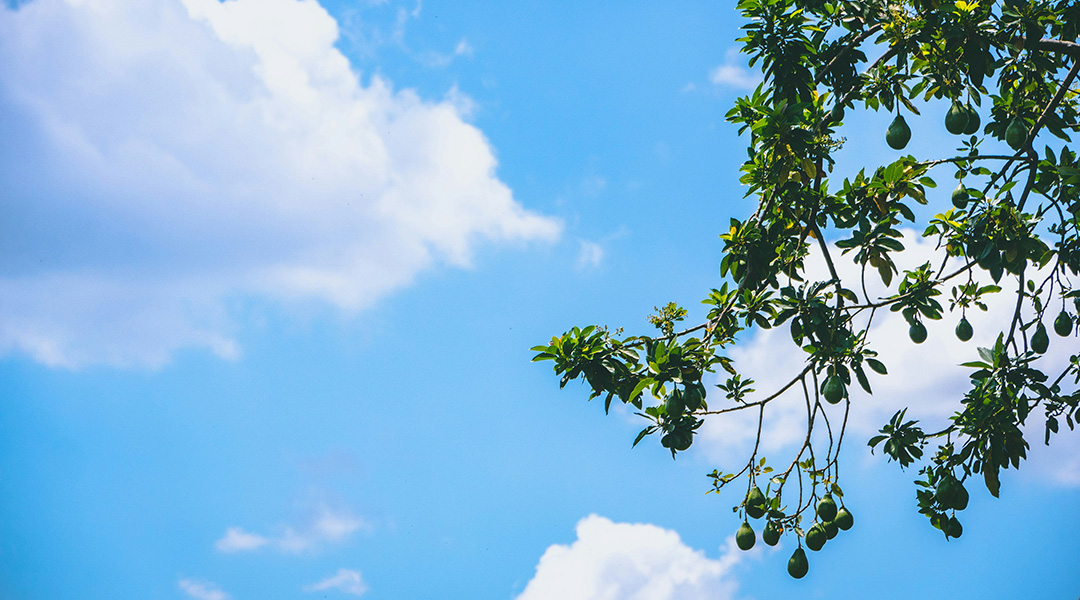Although plastic has allowed for convenient, hygienic food packaging, plastic waste continues to be a major problem for the environment. To make food packaging more sustainable, researchers at the University of Córdoba and the University of Girona in Spain turned to avocado pruning residue — the branches and leaves removed from avocado trees annually.
This residue is a source of biomass, the term given to plant-based materials not consumed as food. Spain’s southern region of Andalucía is ripe with fruit trees, particularly avocado.
“Compared to other avocado byproducts, like pulp and seed, avocado pruning residue has a high cellulose content, similar to other agricultural tree species,” said Eduardo Espinosa, assistant professor at the Chemical Institute for Energy and the Environment at the University of Córdoba, and one of the material’s developers.
Cellulose, a biopolymer found in plants, can be processed into fibers for the reinforcement of synthetic materials, like polyethylene, a nontoxic, inexpensive plastic that has been essential to keeping foods fresh and contamination free.
However, polyethylene is normally derived from fossil fuels and is non-biodegradable, making it unsustainable. Polyethylene produced from bioethanol, a fuel derived from plant-based sources, is a better alternative.
Reinforcing polyethylene
Espinosa and his colleagues aimed to make an environmentally friendly food packaging material by partially substituting bio-polyethylene with fibers extracted from avocado pruning residue.
To produce the lignocellulosic fibers, they concentrated the avocado pruning residue into a pulp and separated the fibers through a fractionation process that preserved some of the lignin — another major component of lignocellulosic biomass.
“This retains interesting properties because the residual lignin content allows us to leverage the advantages of cellulose fibers along with the reactivity and properties provided by lignin,” Espinosa explained.
The researchers then prepared a composite from the bio-polyethylene and lignocellulosic fiber using a high-speed mixer. “The friction generated by the rotation melts the bioplastic and disperses the fibers in the matrix, creating the composite material,” Espinosa stated.
But an additive is needed to strengthen the interaction between the two materials, which are naturally incompatible owing to their different chemical structures — polyethylene is hydrophobic (water-hating) and the fiber is hydrophilic (water-loving). A compound called maleic anhydride, a common additive in plastic manufacturing, is the key to enhancing their compatibility.
“When maleic anhydride is added to the mixture, it positions itself between the fiber and the plastic, reducing the interfacial tension and bonding the two phases together,” Espinosa said. This results in maleic-anhydride-grafted polyethylene.
On a molecular level, the improved bonding interaction arises from the formation of carbon–oxygen bonds between the maleic anhydride molecule and the surface of the lignocellulose fibers. Maleic anhydride also improves the load-bearing capacity of the composite at the interface between the fiber and polymer, which is usually the weakest phase of a composite material.
Advantages of the biocomposite
The composite is not only more biodegradable than bio-polyethylene but also stronger, partially due to the role of maleic anhydride and partially due to the inherent strength of natural fibers.
“Natural fibers possess strong mechanical properties. When these fibers are combined with a thermoplastic matrix like bio-polyethylene, they are dispersed and embedded within the plastic matrix, aiding in the transfer of loads when the material is subjected to mechanical stress,” Espinosa explained.
“Utilizing agricultural waste for biocomposite production adds value to what would otherwise be considered waste, promoting a circular economy and local resource utilization,” he added.
Espinosa also pointed out that their study focused on improving the mechanical properties, specifically the tensile strength, of bio-polyethylene. In reality, food packaging undergoes other types of mechanical stress, such as flexural stress.
“Additionally, the mechanical properties were measured at a temperature of 25°C and a relative humidity of 50%, which may not always reflect the conditions experienced by these materials during the food preservation period,” he said.
We also asked Espinosa if a food packaging material made entirely of lignocellulosic fibers would be practical. “Creating food packaging entirely from the lignocellulosic fibers presents challenges,” he responded.
“Food packaging demands various properties, especially mechanical strength and barrier properties,” he continued. “Since cellulose fibers are highly hygroscopic [they absorb moisture from the air], treating these fibers chemically, and/or with other materials is necessary to develop food packaging materials with high lignocellulosic fiber content.”
In the future, the researchers plan to investigate the environmental impact of their process and assess its economic feasibility. They also need to conduct a shelf-life study of a specific food product using the avocado waste–derived packaging material.
“It would be interesting to test the fibers as a possible raw material for the development of other food packaging formats [in addition to rigid packaging],” Espinosa shared. “These include food films and edible coatings for fruits, among others.”
Reference: Ramón Morcillo-Martín, et al., Avocado Pruning Residues for the Formulation of Bio-Based Polyethylene/Fiber-Based Biocomposites for Sustainable Food Packaging. Advanced Sustainable Systems (2024). DOI: 10.1002/adsu.202300600
Feature image credit: Robin Kutesa on Unsplash

















